The VE Job Plan - ALAGAD Party-List
The VE Job Plan - ALAGAD Party-List
The VE Job Plan - ALAGAD Party-List
You also want an ePaper? Increase the reach of your titles
YUMPU automatically turns print PDFs into web optimized ePapers that Google loves.
THE BBN - LISP SYSTEMREFERENCE MANUALAPRIL 1969( D.G. Bobrow, D.L. Murphy, W. Teitelman:)Bolt Beranek and Newman Inc
Why adefiniteplan<strong>The</strong> <strong>VE</strong> <strong>Job</strong> <strong>Plan</strong> consists of those tasks orfunctions necessary to properly perform a <strong>VE</strong>study.Adherence to a definite plan is essential toachieving optimum results.Use of the <strong>Job</strong> <strong>Plan</strong> provides:a. A vehicle to carry the study frominception to conclusion.b. A convenient basis for maintaining awritten record of the effort as itprogresses.c. Assurance that consideration has beengiven to facts that may have beenneglected in the creation of theoriginal design.d. A logical separation of the study intounits that can be planned, scheduled,budgeted and assessed.Part 3.2
Phases ofthe planSeveral versions of the <strong>VE</strong> <strong>Job</strong> <strong>Plan</strong> aredescribed in current <strong>VE</strong> literature.Some sources list five phases, and othersrange up to eight.<strong>The</strong> number of phases into which the studyprocedure is divided is less importantthan the systematic approach implied.We will be using the seven-phase approachshown in Figure 5.Actually there are no sharp lines ofdistinction between the phases.<strong>The</strong>y tend to overlap in varying degreesand generally require some recyclingthrough several phases of the projectplan.An effective <strong>VE</strong> effort must include allphases of the <strong>Job</strong> <strong>Plan</strong>.However, the proper share of attentiongiven to each phase may differ from oneeffort to another.Part 3.3
OrientationphaseFigure 5 indicates an orientationphase just prior to Phase I.This phase is not numbered because itrelates to the initiation of ideas forprojects and their evaluation,selection, planning and authorizationrather than the steps for conducting aspecific project.Project selection is outside thecontrol of the value study team. Ingeneral, the criteria used to selectprojects includes:a. high cost projects,b. projects that “are just not worththe expenditure necessary tocomplete them,c. projects which really need to bedone, but never have a high enoughpriority overall to meet the budgetcut-off, andd. problem projectsPart 3.4
ORIENTATIONPROCEDURESUBMIT IDEAS FOR PROJECTSEVALUATE THEIR POTENTIAL FOR RETURN ON IN<strong>VE</strong>STMENT AND FORTIME TO IMPLEMENT RESULTSSELECT PROJECTS FOR PLANNINGPLAN THE SPECIFIC PROJECTAPPOINT THE TEAMALLOCATE RESOURCESSET GOALSSET MILESTONESRECONFIRM PROJECT POTENTIALESTABLISH PRIORITYAPPRO<strong>VE</strong> PROJECT STARTFigure 5.0 – Orientation Phase of the <strong>Job</strong> <strong>Plan</strong>Part 3.5
2. SPECULATION PHASEQUESTIONWHAT ELSE WILL DO THE JOB?TECHNIOUESBLAST-CREATE REFINEFUNCTIONAL COMPARISONSIMPLE COMPARISONSCIENTIFIC SEARCHBRAINSTORMINGPROCEDUREFREE WHEELTRY E<strong>VE</strong>RYTHINGO<strong>VE</strong>R-SIMPLIFYMODIFY AND REFINEELIMINATEFigure 5.2 – Phase 2 of the <strong>Job</strong> <strong>Plan</strong>Part 3.7
3. ANALYSIS PHASEQUESTIONSWHAT DOES EACH COST?WILL EACH PERFORM THE BASIC FUNCTION(S)?TECHNIQUESEVALUATE BYCOMPARISONADVANTAGE VS DISADVANTAGERANKINGCHECKLISTPROBABILITYCREATI<strong>VE</strong> APPROACHPROCEDUREESTABLISH CRITERIAEVALUATE IDEASPUT $ ON EACH IDEAUSE SERVICES OF EXPERTSUSE OWN JUDGEMENTREFINE IDEASFigure 5.3 – Phase 3 of the <strong>Job</strong> <strong>Plan</strong>Part 3.8
6. IMPLEMENTATION PHASEPROCEDUREFUND IT!TRANSLATE IDEAS TO ACTIONSPRE<strong>VE</strong>NT IDEA COMPROMISEEXPEDITEUSE <strong>VE</strong> TEAMSOL<strong>VE</strong> PROBLEMSO<strong>VE</strong>RCOME ROADBLOCKSMONITOR PROGRESSSET DEADLINESDESIGNATE RESPONSIBILITIESFigure 5.6 – Phase 6 of the <strong>Job</strong> <strong>Plan</strong>Part 3.11
7. FOLLOW-UP PHASEPROCEDUREAUDIT ACTUAL RESULTSPREPARE REPORTSCOST SAVINGSTECHNICAL CROSSFEEDEVALUATE PROJECT CONDUCTINITIATE NEW PROJECT IDEASMAKE AWARDSFigure 5.7 – Phase 7 of the <strong>Job</strong> <strong>Plan</strong>Part 3.12
Phase I -Informationa. Objectives. <strong>The</strong> first Phase of the<strong>Job</strong> <strong>Plan</strong> has two basic objectives.(1) to obtain thorough understandingof the system, operation or itemunder study by a rigorous reviewof all of the pertinent factualdata, and(2) to define the value problem bymeans of functional descriptionaccompanied by an estimate ofthe worth of accomplishing eachbasic function.b. Key questions. During this phasethe following key questions must beanswered:What is it?What does it do?What must it do?What does it cost?What is it worth?c. Procedure(1) Good human relations.<strong>The</strong> matter of human relations is ofutmost importance to the success ofany <strong>VE</strong> study. "People problems" areusually more difficult to resolvethan technical problems.<strong>The</strong> effectiveness of a person'sefforts depends upon the amount ofcooperation he is able to obtainfrom engineers, designers,estimators, managers, etc.Part 3.13
If he is adroit in his approach,diplomatic when resolving opposingviewpoints, and tactful inquestioning a design requirement orspecification, he will minimize theproblems of obtaining thecooperation he must have if he is todo his job effectively.(2) Collecting information.All pertinent facts concerning thesystem, operation or item must bedrawn together.<strong>The</strong> paramount considerations are:(a) getting all the facts, and(b) getting them from the bestsources.<strong>The</strong> <strong>VE</strong> team should gather completeinformation consistent with thestudy schedule.All relevant information isimportant, regardless of howdisorganized or unrelated it mayseem when gathered.Wait until all facts have beengathered before organizing them.<strong>The</strong> data gathered should besupported by tangible evidence inthe form of copies of allappropriate documents.Where supported facts are notobtainable, the opinions ofknowledgeable persons should bedocumented.Figure 6 provides a checklist of thetype of information to seek toassure getting all the facts.Part 3.14
Phase II -Speculationa. Objective.<strong>The</strong> objective of this phase is togenerate, by creative techniquesnumerous alternative means foraccomplishing the basic functionsidentified.b. Key question.Accomplishing this phase shouldresult in answering the question"What else will do the job (performthe basic functions)?"<strong>The</strong> completeness andcomprehensiveness of the answer tothis question determines to a veryhigh degree the effectiveness andcaliber of value work.<strong>The</strong> greater the number and qualityof alternatives uncovered, thegreater the likelihood of developingan outstanding solution.Additional alternatives which havenot been considered will usuallyexist regardless of the skill andproficiency of the study team.c. Procedure.Consideration of alternate solutionsshould not formally begin until theproblem is thoroughly understood.All members of the <strong>VE</strong> study teamshould participate, for the greaterthe number of ideas conceived themore likely that equally effective,less costly alternatives will beamong them.A proper frame of mind is importantat this stage of the study; creativethinking should replace theconventional.Part 3.17
It should be a unique flight of theimagination undertaken to generatenumerous alternate methods ofproviding the necessary function.Judicial thinking does not belong inthis phase.As an aid to speculative thought,the techniques of creative thinking,such as brainstorming, should beemployed along with the <strong>VE</strong> techniqueof "blast, create, and refine."Every attempt should be made duringthis phase to depart from ordinarypatterns, typical solutions andhabitual methods.Experience indicates that it isoften the new, fresh and radicallydifferent approach that uncovers thebest value solution.<strong>The</strong> individual or group members maysupplement their ideas with those ofothers - everyone is expected tomake his contribution.<strong>The</strong> best solution may be completeelimination of the present functionor item.This possibility should not beoverlooked during the initial phasesof this step.Perhaps some aspect can be modifiedwhich will permit elimination of thefunction under study.Only after determining that thefunction must remain, should thestudy group look for alternate waysto perform the same function at thelowest conceivable cost.Part 3.18
Free use of imagination isencouraged so that all possiblesolutions are considered.Figure 8 is a partial list ofquestions that can be used tostimulate and trigger ideas.<strong>The</strong> questions shown can be rephrasedby substituting terms like "system,""item," or "procedure" for the words"it" or "part" when appropriate forthe particular project.d. Techniques to use.(1) Blast, create and refine.Blast, get off the beaten path.Create, really reach for anunusual idea; reach way out foranother approach. Refine,strengthen or add to develop anidea to perform basic functionsin a new and unique manner.(2) Functional comparison.Conduct a creative problemsolving session (brainstorming)in which new and unusualcontributions of known things orprocesses are combined and/orrearranged providing differentways of performing basicfunctions.(3) Simple comparison.Conduct a thorough search forother items which are similar inat lest one significantcharacteristic to the studyitem. Determine if they can bemodified to satisfy basicfunctions.Part 3.19
(4) Scientific search.Conduct a search for otherscientific disciplines capableof performing the same basicfunction.This involves interviewingspecialists in disciplines whichdid not previously contribute tosolving the problem.An industry (or itsrepresentatives) whichspecializes in some highlyskilled technique often can makea substantial contribution whenthey are called upon fortechnical assistance.Part 3.20
PEOPLE SOURCESGO<strong>VE</strong>RNMENTCOMMERCIALProject managers, design engineers,owners, users, managers, operators,maintenance forces. specialists, etc.Architectural and Engineering firms,contractors, fabricators, suppliers,vendors, distributors, expertconsultants, etc.DATA SOURCESPROJECT DATACRITERIA DATAEXPERIENCE DATACOMMERCIAL DATAHISTORICAL DATA<strong>Plan</strong>ning documents, drawings,specifications, sketches,computations, cost estimates,material lists, financial records,CPM schedules, contract forms, A&Escope of work, etc.Handbooks, orders, standardspecifications, Commercial andGovernment standards, published userregulations and requirements ,engineering manuals, maintenancemanuals, etc.Test reports, maintenance reports,user feedback, technical crossfeedreports, etc.Catalogues, product literature,technical publications, magazines,etc.Libraries, previous studies datafiles, management informationsystems, previous designs andcontracts, conference and symposiumproceedings, etc.Figure 7. Checklist for Sources of InformationPart 3.22
ELIMINATE - COMBINECan it be eliminated entirely?Can part of it be eliminated?Can two parts be combined into one? Is there duplication?Can the number of lengths, colors, types, be reduced?STANDARDIZE - SIMPLIFYCould a standard part be used?Would a modified standard part work?Does the standard contribute to cost?Does anything prevent it from being standardized?Is it too complex? Can connections be simplified?Is it over-detailed or over-specified?CHALLENGE - IDENTIFYDoes it do more than is required?Does it cost more than it is worth?Is someone else buying it at lower cost?What is special about it?Is it justified?Can tolerances be relaxed?Have drawings and specifications been coordinated?MAINTAIN - OPERATEIs it accessible?Are service calls excessive?Would you like to own it and pay for its maintenance?Is labor inordinate to the cost of materials?How often is it actually used?Does it cause problems?Have users established procedures to get around it?REQUIREMENTS - COSTAre any requirements excessive?Can less expensive materials be used?Is it proprietary?Are factors of safety too high?Are calculations always rounded off on the high side?Would lighter gauge materials work?Could a different finish be used?Figure 8. Idea StimulatorsPart 3.23
FACTORPOSSIBLE RATINGSAbility to performbasic functionExcellentGoodFairPoorUsability of the ideaUse nowModifyHoldRejectEase of ideaimplementationconsidering complexityand scheduleSimple ideaModerately complexComplex ideaFigure 11. Typical Analysis Rating SystemPart 3.24
1. Review all phases of the program beingevaluated (creative phase).2. Designate the subordinate problems requiringsolution (judicial phase).3. Determine the data that might help with theevaluation (creative phase).4. Determine the most likely sources of data(judicial phase).5. Conceive as many ideas as possible that relateto the problem (creative phase).6. Select for further study those ideas, conceivedin stop 5, which seem most likely to lead to asolution of the problem (judicial phase).7. Consider all the possible ways to test theideas chosen (creative phase).8. Select the soundest ways of testing the ideas(judicial phase).9. Decide on the final ideas to be used in theprogram (judicial phase).Figure 9. Analysis TechniquePart 3.25
a. Will the idea work?b. Can it be modified or combined with another?c. What is the savings potential?d. What are the chances for implementation?e. What might be affected?f. Who might be affected?g. Will it be relatively difficult or easy to makethe change?h. Will it satisfy all the user's needs?Figure 10. Analysis CriteriaPart 3.26
Phase IIIAnalysisa. Objectives<strong>The</strong> purpose of this phase is toselect for further analysis andrefinement the most promisingalternatives from among thosegenerated during the previous phase.During speculation, in the interestof the creative process, a consciouseffort is made to prohibit anyaccepted, judicial thinking.Since many of the ideas may not befeasible, all must be criticallyevaluated.b. Key questions to answer during thisphase are:(1) What does each cost?(2) Will each perform the basicfunctions?c. Techniques.Several techniques are available bywhich alternative ideas can beevaluated and judged. <strong>The</strong>se are:(1) Comparison technique.<strong>The</strong> comparison technique ofevaluation is a method ofcomparing the various featuresof the alternatives underconsideration.However, the technique is usefulonly if the alternatives aresimilar and can be compared inthe first place.Part 3.27
(2) Advantages versus disadvantagestechnique.In this technique the evaluatorlists first the advantages anddisadvantages of each alternative<strong>The</strong> next step is to sort theideas on the basis of a weighingprocess in which the number ofadvantages and disadvantageswould be considered.Those ideas with the greatestweight in terms of advantageswould be chosen for furtherevaluation.(3) Ranking technique.<strong>The</strong> ranking technique allows theevaluators to assign a numericalrating to these variousalternatives.Persons using this process mightstart out by judging a very goodidea to be worth 10 points; agood idea, 8 points; a fairidea, 6 points; a poor idea, 4points; a very poor idea, 2points.Next, all 10-point ideas aregrouped and further evaluated,using this same process.<strong>The</strong> same method could be used on8-point ideas, and if necessary,on the 6-point ideas.(4) Checklist technique.This technique is based on achecklist which evaluators useto insure their choice of thebest decisions.Part 3.28
(5) Probabilities technique.In this technique, theevaluators assign subjectiveprobabilities of success to theimplementation of acceptableideas.A probability close to one (1)means the idea has a good chanceof being implemented.A probability close to zero (0)means the idea has little if anychance of being adopted.(6) Creativity approach.d. ProcedureThis approach is based on thealternate use of the creativeand judicial thinking processesfor each basic idea to beevaluated.<strong>The</strong> evaluator might take thesteps shown in Figure 9.Evaluation may be accomplishedeither by the generating group or byan independent group.Authorities disagree upon whichapproach is better.<strong>The</strong> disagreement grows out of thequestion as to whether people whogenerate the ideas can be objectiveenough in evaluating them.(1) Evaluation criteria.<strong>The</strong> first step is to develop aset of evaluation criteriastandardsby which to judge theideas.Part 3.29
In developing these criteria,the team should try toanticipate all of the effects,repercussions, and consequencesthat might occur in trying toaccomplish a solution.<strong>The</strong> resultant criteria shouldresult, in a sense, as a measureof sensitivity to problems(which might be inherent inchanges caused by the new idea).Figure 10 provides a listing ofseveral different criteria thatcould be used in the analysisphase.Factors such as those are reallythe yardsticks by which theeffectiveness of each idea canbe tested.(2) Screening process.<strong>The</strong> next step in the procedureis the actual ranking of ideasaccording to the criteriadeveloped.No idea should be discarded; allshould be given this preliminaryevaluation as objectively aspossible.Figure 11 illustrates a typicalsystem used to rate ideas.Ratings and their weights arebased on the judgment of personsperforming the evaluation.This initial analysis willproduce a shorter list ofalternatives, each of which haspassed the evaluation standardsset by the team.Part 3.30
(3) Define alternatives.<strong>The</strong> remaining alternatives arethen ranked according to anestimate of their relative costreduction potential.<strong>The</strong> ranking may be based onnothing more than relativeestimates comparing theelements, materials, andprocesses of the alternativesand the original or presentmethod of providing thefunction.<strong>The</strong> surviving alternatives arethen developed further to obtainmore detailed cost estimates.<strong>The</strong> cost estimating for eachalternative proceeds only if thepreceding step indicates itstill to be a good candidate.Although the analysis phase isthe responsibility of the <strong>VE</strong>team, authorities andspecialists should be consultedin estimating the potential ofthese alternatives.Cost estimates must be ascomplete, accurate, andconsistent as possible tominimize the possibility oferror in assessing the relativeeconomic potential of thealternatives.Specifically, the method used tocost the original or presentmethod should also be used tocost the alternatives.Part 3.31
(4) Final selectionAfter the detailed costestimates are developed for theremaining alternatives, one ormore are selected for furtherstudy, refinement, testing, andinformation gathering.Normally, the alternative withthe greatest savings potentialwill be selected.However, if the severalalternatives are not decisivelydifferent at this point, theyshould all be developed further.Part 3.32
Phase IV -Developmenta. Objective.In this phase, selected idea orideas are fully developed with theintent of making specificrecommendations for change tomanagement.<strong>The</strong> process involves not onlydetailed technical and economictesting but also an assessment ofthe probability of successfulimplementation.b. Key questions.Several questions must be answeredduring the development of specificsolutions. <strong>The</strong>se are:(1) Will it work?(2) Will it meet all necessaryrequirements?(3) Who has to approve it?(4) What are the implementationproblems?(5) What are the costs?(6) What are the savings?c. Procedures.(1) GeneralIn order to satisfy thequestions above, eachalternative must subjected to:(a) careful analysis to insureuser's needs are satisfied;(b) a determination of technicaladequacy;Part 3.33
(c) the development of estimatesof costs, implementationexpenses, and schedules,including schedules andcosts of all necessarytests; and(d) consideration of changeoverrequirements and impact.(2) Develop convincing factsAs in the Information Phase, theuse of good human relations isof considerable importance tothe success of the DevelopmentPhase.In developing answers to thequestions above, the <strong>VE</strong> teamshould consult with cognizantpersonnel concerned with whatthe item must do, within whatconstraints it must perform, howdependable the Item must be, andunder what environmentalconditions it must operate.Any technical problems relatedto design implementation,procurement or operation must bedetermined and resolved.Consideration must be given toimpact in areas such as safety,fire protection, maintenance andsupply support.(3) Develop specific alternatesThose alternates that stand upunder close technical scrutinyshould be followed through tothe development of specificdesigns and recommendations.Part 3.34
implementation.Other testing and evaluationthat may be required, should beplanned for and scheduled in therecommended implementationprocess.Required testing should notdelay approval of a proposalwhen:(a) risk of failure is low,(b) consequences of failurewould involve nothing moreserious than cost,(c) the element being testedinvolves an intangible orsubjective-factor, and(d) the test is a normalconfirmation procedure afteran action is taken.(6) Select first choiceFinally, one alternative shouldbe selected for implementation,as the best value (best costreduction) alternative, and oneor more other alternativesselected for presentation in theevent the first choice isrejected by the approvalauthority.<strong>The</strong> implementation schedulewhich will yield the greatestcost reduction should also beindicated.Part 3.36
Phase V -Presentationa. Objective.This phase involves the actualpreparation and presentation of thebest alternatives to persons havingthe authority to approve the <strong>VE</strong>proposals.This phase of the <strong>VE</strong> <strong>Job</strong> <strong>Plan</strong>includes the following steps:(1) Preparing and presenting the <strong>VE</strong>proposals.(2) Presenting a plan of action thatwill insure Implementation ofthe selected alternatives.(3) Obtaining a decision of positiveapproval.b. Discussion.A <strong>VE</strong>P is a challenge to the "statusquo" of any organization.It is a recommendation for change.<strong>The</strong> recommendation was developedthrough a team effort and itsadoption is dependent upon anotherteam effort.<strong>The</strong> success of a <strong>VE</strong> project ismeasured by the savings achievedfrom implemented proposals.Regardless of the effort investedand the merits of the proposal, thenet benefit is zero if the proposalsare not implemented.Presenting a proposal andsubsequently guiding it toimplementation often requires moreeffort than its actual generation.Part 3.37
This paragraph reviews someprinciples and practices which havebeen successfully used to facilitatethe approval of <strong>VE</strong>Ps.c. Form.Presentation of a <strong>VE</strong> proposal shouldalways be made in written form.Oral presentation of study resultsis most helpful to the person who isresponsible for making the decision;however, it should never replace thewritten report.A written report normally demandsand receives a written reply,whereas oral reports can beforgotten and overlooked as soon asthey are presented.In the rush to wrap up a project,promote a great idea, or save thelaborious effort of writing areport, many proposals have fallenby the way side because the oralpresentation came first and wasinadequate.<strong>The</strong> systematic approach of the <strong>VE</strong><strong>Job</strong> <strong>Plan</strong> must be followed all theway through to include thesystematic, meticulous, carefulpreparation of a written report.From this, then, will evolve a moreconcise and successful oralpresentation.d. Format.During the course of a <strong>VE</strong> project,two major documents should beproduced:A report summarizing the results ofthe effort andPart 3.38
a project book that contains all thedetailed back-up information.e. Content.Management, responsible for reviewand approval, must base its judgmenton the documentation submitted witha proposal.<strong>The</strong> proposal and supportingdocumentation should provide all ofthe data the reviewer will need toreach a decision.Top management is primarilyconcerned with net benefit anddisposition.A manager may either be competent inthe areas affected by the proposalor he may rely on the advice ofspecialists.In either case, completelydocumented proposals are far morelikely to be implemented.Generally proposals should containsufficient discussion to assure thereviewer that:(1) Item/system performance is notadverse affected,(2) supporting technicalinformation is complete andaccurate,(3) potential savings are based onvalid cost analysis, and(4) the change is feasible.<strong>The</strong> <strong>VE</strong> Workbook is compiled throughoutthe life of a project, starting withthe Information Phase. If properlymaintained during the project, theworkbook should require no additionalpreparation effort during this phase.Part 3.39
maintained during the project, theworkbook should require no additionalpreparation effort during this phase.It should be a complete and readydocument to facilitate preparation ofthe Executive Brief and support theteam's recommendations.Figure 12. lists the type ofinformation that should be recorded inthe workbook.<strong>The</strong> Executive Brief is prepared topresent a specific <strong>VE</strong>P to the busydecision maker in such a form that theproposal is self-explanatory andleaves no doubt concerning itsjustification.It must be concise, yet it must bedesigned to secure the requiredapproval by anticipating objectionsand providing answers.Figure 13 lists the type ofinformation that should be in theExecutive Brief.Other points for consideration duringpreparation are:(a) If the study has the approval ofother authorities, cite this asan indication of broadorganizational support.(b) <strong>The</strong> use of supplementary datadepends on the nature of thereport. In long, complexreports, the use of simplecharts, figures, and tables maybe far more effective than pagesof technical material, dates,and statistics.Illustrations and photographsoffer welcome relief from pagesof text.Part 3.40
of text.(c) Consider the approach andprocedures used by others inviewing and evaluating theproposal. If the report does notcommunicate effectively, thewhole study is in jeopardy.(d) Leave generalized statements outof a proposal. <strong>The</strong> dangerinherent in a generalizedstatement is that if oneexception can be found, thestatement is proven wrong.(e) Be brief and pertinent. Presentthe facts clearly, concisely andconvincingly.f. Gaining <strong>VE</strong>P acceptance<strong>The</strong>re are many hints which may beoffered to improve the probabilityand reduce the time required foracceptance and implementation ofproposals.Those which appear to be mostsuccessful are discussed in thefollowing paragraphs:(1) Consider the Reviewer's Needs.Use terminology appropriate tothe training and experience ofthe reviewer.Each proposal is usuallydirected toward two audiences:First is the technical authoritywho requires sufficienttechnical detail to demonstratethe engineering feasibility ofthe proposed change.Part 3.41
Second are the administrativereviewers for whom the technicaldetails can be summarized whilethe financial implications(implementation costs and likelybenefits) are emphasized.Long-range effects on policies,procurement, and applicationsare usually more significant tothe manager than to theengineer.(2) Progress Reports --"NoSurprises".<strong>The</strong> manager who makes aninvestment in a <strong>VE</strong> study expectsto receive periodic progressreports with estimates ofpotential results.Reporting is a normal andreasonable requirement ofmanagement.It helps assure top managementawareness, support, andparticipation in any improvementprogram.<strong>The</strong>re are very few instanceswhere managers have beenmotivated to act by a one-timeexposure at the "finalpresentation," no matter how"just" the cause.<strong>The</strong>refore, it is advisable todiscuss the change with thedecision makers or theiradvisors, prior to its submittalas a formal <strong>VE</strong>P.This practice familiarizes keypersonnel with impendingproposals, and enables them toevaluate them more quickly aftersubmittal.Part 3.42
submittal.Early disclosure may also serveto warn the originators of anyobjections to the proposal.This "early warning" will givethe originators opportunity toincorporate modifications toovercome the objections.Often these preliminarydiscussions produce additionalsuggestions which improve theproposal and enable the decisionmaker to contribute directly.If management has been keptinformed of progress, the <strong>VE</strong>Ppresentation may be only aconcise summary of finalestimates, pro and condiscussion, and perhaps formalmanagement approval.(3) Relate Benefits toOrganizational Objectives.<strong>The</strong> <strong>VE</strong>P which represents anadvancement toward some approvedobjective is most likely toreceive favorable considerationfrom management.In the client's organization,the potential of a <strong>VE</strong>P is not aprofit but a capability.<strong>The</strong>refore the presentationshould exploit all of theadvantages a <strong>VE</strong>P may offertoward fulfilling organizationalobjectives and goals.When reviewing a <strong>VE</strong>P, theclient's manager normally seekseither lower total cost ofownership, or increasedcapability, for the same orlesser dollar investment.Part 3.43
capability, for the same orlesser dollar investment.<strong>The</strong> objective may be not onlysavings but also the attainmentof some other mission relatedgoal of the manager.(4) Support the Decision Maker.<strong>The</strong> dollar yield of a <strong>VE</strong>P islikely to be improved promptlyimplemented.Prompt implementation in turn,is dependent upon theexpeditious approval of theindividuals responsible for adecision in each organizationalcomponent affected by theproposal.<strong>The</strong>se individuals should beidentified and entire <strong>VE</strong> effortconducted under theirsponsorship.<strong>The</strong> <strong>VE</strong> group becomes thedecision maker's staff preparinginformation in such a mannerthat he can weigh the riskagainst the potential reward.Like any other well preparedstaff report, each <strong>VE</strong>P should:(5) Minimize Risk.If <strong>VE</strong> Proposals presented tomanagement are to be givenserious consideration, theyshould include adequate evidenceof satisfactory return on theinvestment.Often current contract savingsalone will assure an adequatereturn. In other cases lifecycle or total program savingsmust be considered.Part 3.44
cycle or total program savingsmust be considered.Either way, evidence ofsubstantial benefits willimprove the acceptability of aproposal.<strong>The</strong> cost and time spent intesting to determine theacceptability of a <strong>VE</strong> proposalmay offset a significant portionof its savings potential.Committing such an investmentwith no guarantee of successconstitutes a risk which coulddeter acceptance of a <strong>VE</strong>P.This risk may be reduced byprudent design and scheduling oftest programs to provideintermediate assurancesindicating the desirability ofcontinuing with the next step.Thus, the test program may beterminated or the proposalmodified when the concept firstfails to perform an acceptablelevel.Major expenditures forimplementing proposed <strong>VE</strong> actionsshould not be presented as alump-sum aggregate, but ratheras a sequence of minimum riskincrements.A manager may be reluctant torisk a total Investment againsttotal return, but may be willingto chance the first phase of aninvestment sequence.Each successive investmentincrement would be based uponPart 3.45
the successful completion of theprevious step.(6) Combine Testing.Occasionally a significantreduction in implementationinvestment is possible byconcurrent testing of two ormore proposals.Also, significant reductions intest cost can often be made byscheduling tests into other testprograms scheduled within thedesirable time frame.This is particularly true whenitems to be tested are a part ofa larger system also beingtested.However, care must be exercisedin instances of combined testingto prevent masking thefeasibility of one concept bythe failure of another.(7) Show Collateral Benefits of theInvestment.Often <strong>VE</strong> proposals offer greaterbenefits than the costimprovements specificallyidentified.Some of the benefits arecollateral in nature anddifficult to equate to monetaryterms.Nevertheless, collateralbenefits should be included inthe proposal.<strong>The</strong> likelihood of acceptance ofthe <strong>VE</strong>P is improved when all itscollateral benefits are clearlyidentified and completelydescribed.Part 3.46
identified and completelydescribed.(8) Acknowledging Contributors.An implemented <strong>VE</strong> proposalalways results from a groupeffort.<strong>The</strong>re is a moral obligation toidentify all individuals anddata sources contributing to aproposal.Identification of contributorsalso provides the reviewers witha directory of sources fromwhich additional information maybe obtained.Individuals, departments, andorganizations should becommended when it is deserved.This recognition promotescooperation and participationessential to the success ofsubsequent <strong>VE</strong> efforts.(a) Satisfy questions thedecision maker is likely toask.(b) Respect his authority.(c) Permit him to preserve hisprofessional integrity.(d) Imply assurance thatapproval would enhance hisimage.(e) Include sufficientdocumentation to warrant afavorable decision withreasonable risk factors(both technical andeconomic).Part 3.47
• Identification of the project selected.• A brief summary of the problem.• An "explanation for the choice of thissystem or item for study, withinformation on the quantities involved.• A functional evaluation of the electedsystem or item, major subassemblies, orcomponents.• All pertinent information gathered bythe group and its source.• A complete list of all the alternativesconsidered. Detailed information on theevaluation of all ideas.• An explanation of logical alternativesinvestigated and reasons for theirrejection.• Detailed technical data supporting theideas selected, and any other factualinformation which enabled selection ofthe most favorable alternatives.• Original costs, cost of implementing theproposed alternatives, and cost datasupporting all savings being claimed.• Steps necessary to implement theproposed alternatives.• Before-and-after sketches of the systemor item under study,Figure 12. Workbook Data ChecklistPart 3.48
• Identification of the project studied.• Brief summary of the problem ordescription of original design.• Cost of original design.• Results of the functional analysis.• Technical data supporting selection of aproposal. Cost data supporting theproposal.• Explanation of advantages anddisadvantages and reasons for acceptingthe proposal.• Sketches of before and after designs,clearly depicting proposed changes.• Estimated net savings.• A recommended plan of implementationconsidering cost and schedule.• A request for approval of the proposalor a meeting to discuss it further.• Acknowledgements of contributions madeby others to the study.Figure 13. Executive Brief Data ChecklistPart 3.49
g. Oral Presentation<strong>The</strong> oral presentation can be thekeystone to selling a proposal. Itgives the <strong>VE</strong> team a chance to insurethat the written proposal iscorrectly understood and that propercommunication exists between theparties concerned.Effectiveness of the presentationwill be enhanced if:(1) <strong>The</strong> entire team is present andis introduced.(2) <strong>The</strong> presentation lasts no longerthan 15 minutes with time forquestions at the end.(3) <strong>The</strong> presentation is illustratedthrough the use of mockups,models, slides, vu-graph, opaqueprojector, or flip charts.(4) <strong>The</strong> team is prepared withsufficient back-up material toanswer all questions during thepresentation.Part 3.50
Phase VIImplementationa. Objective.During this phasemanagement must insure thatapproved recommendationsare converted into actions.Until this is done, savingsto offset the cost of thestudy will not be achieved.Three major objectives ofthis phase are:(1) To provide assistance,clear upmisconceptions, andresolve problems thatmay develop in theimplementation process.(2) To minimize delaysencountered by theproposal in theimplementation process.(3) To insure that approvedideas are not modifiedduring theimplementation processin such a manner thatcompromise would causethem to lose their costeffectiveness or basisfor original selection.b. Implementation investment.<strong>The</strong> need to invest to savemust be emphasized whensubmitting <strong>VE</strong>Ps.Some degree of investmentis required if a <strong>VE</strong>opportunity is to become areality.Part 3.51
Funds for implementationhave to be provided.<strong>The</strong> key to successfulimplementation lies inplacing "work orders" forthe necessary actions intothe normal routine ofbusiness.Progress should be reviewedperiodically to insure thatany roadblocks which ariseare overcome promptly.c. Expediting implementation.<strong>The</strong> fastest way to achieveimplementation of an ideais to effectively utilizethe knowledge gained bythose who originated it.Whenever possible, the <strong>VE</strong>team should be required toprepare first drafts ofdocuments necessary torevise handbooks,specifications, A&E scopes,change orders, drawings andcontract requirements.Such drafts will help toinsure proper translationof the idea into action andwill serve as a baselinefrom which to monitorprogress of finalimplementation.To further insure propercommunication andtranslation of the ideaonto paper, the <strong>VE</strong> teamshould review allimplementation actionsprior to final release.Part 3.52
d. Monitoring progress.Implementation progressmust be monitored just assystematically as the <strong>VE</strong>Pdevelopment.It is the responsibilityof management to insurethat implementation isactually achieved.Suggested procedures forthis are:(1) Designate a person, byname, withresponsibility tomonitor all deadlinedates in theimplementation plan.(2) Designate a person, byname, withresponsibility toimplement the <strong>VE</strong>P andmeet the deadlinedates established.Part 3.53
Phase VII -Follow-Upa. Objective.This last phase of the <strong>Job</strong> <strong>Plan</strong>has several objectives listedbelow.<strong>The</strong>y might seem quite diversebut when achieved in total,they will serve to foster andpromote the success ofsubsequent <strong>VE</strong> efforts.(1) Obtain hard copies of allcompleted implementationactions.(2) Compare actual results withoriginal expectations.(3) Submit cost savingsachievement reports tomanagement.(4) Submit technical crossfeedreports to management.(5) Evaluate conduct of theproject to identifyproblems that arose andrecommend corrective actionfor the next project.(6) Initiate recommendationsfor potential <strong>VE</strong> study onideas evolving from thestudy just completed.(7) Screen all contributors tothe <strong>VE</strong>P for possiblereceipt of an award andinitiate recommendationsfor appropriaterecognition.b. Discussion.A <strong>VE</strong> Project is not completedwith implementation of an idea.Part 3.54
with implementation of an idea.Full benefit is not derivedfrom a <strong>VE</strong>P until the follow-upphase is completed. Until then,the records on a project cannotbe closed.All of the objectives listedfor this phase are selfexplanatory.Most of these objectives are soobvious that they arefrequently overlooked.Sometimes they are notaccomplished because theyrequire effort (time-moneyenergy)to accomplish them.Yet, each objective isessential, for its own reason,to the continuing success of<strong>VE</strong>.c. AccomplishmentIt is the responsibility ofmanagement to designate someindividual to complete thisphase of the <strong>Job</strong> <strong>Plan</strong>. <strong>The</strong> listof objectives should be used asa checklist to insure that eachhas been considered andaccomplished.d. Key QuestionsProper completion of this phaseshould answer the types ofquestions shown in Figure 14.Part 3.55
• Did the idea work?• Did the client save money?• Would you do it again?• Could it benefit others?• Has it been forwarded to the CentralOffice?• Has it had proper publicity?• Should any awards be made?Figure 14. Follow-up QuestionsPart 3.56
Summary<strong>The</strong> <strong>VE</strong> <strong>Job</strong> <strong>Plan</strong> can be applied to anysubject suitable for a <strong>VE</strong> study.In serving as a vehicle to carry thestudy from inception to conclusion andin observing certain formalities, the<strong>VE</strong> <strong>Job</strong> <strong>Plan</strong> insures that considerationis given to all necessary facets ofthe study.Although the <strong>Job</strong> <strong>Plan</strong> divides thestudy into a distinct set of workelements, judgment is necessary todetermine the depth to which eachphase is performed.In fact, each plan must be made inlight of the resources available andthe results expected.<strong>The</strong> <strong>VE</strong> <strong>Job</strong> <strong>Plan</strong> requires those makingthe study to clearly define thefunctions performed by the item understudy.Adherence to the <strong>Job</strong> <strong>Plan</strong> insures thattime is made available for theessential creative work and thenecessary analysis of this creativework so that best choices can be madefor further development.<strong>The</strong> <strong>Job</strong> <strong>Plan</strong> leads to theestablishment of an effective programaimed at the selection of the bestvalue alternatives.And, finally, it concludes withspecific recommendations, thenecessary data supporting them, theidentification of necessaryimplementing actions, a proposedimplementation scheduled and arequired follow-up procedure.<strong>The</strong> <strong>Job</strong> <strong>Plan</strong> is normally followed insequence, phase by phase. However, inactual practice it is often necessaryto do additional work to a previouslycompleted phase before reaching adecision.Part 3.57
actual practice it is often necessaryto do additional work to a previouslycompleted phase before reaching adecision.Thus, in practice, the phases mayoverlap broadly, and such early stepsas information gathering may continuethroughout most of the <strong>VE</strong> effort.Typically, two major documents areproduced: a report summarizing theresults of the effort and a projectbook that contains all the detailedback-up information.<strong>The</strong> <strong>VE</strong> <strong>Job</strong> <strong>Plan</strong> is a planned programthat has been tested, is being used,and has proved to be workable.<strong>The</strong> <strong>VE</strong> <strong>Job</strong> <strong>Plan</strong> may be keyed to theword "value" in this manner:a. Validate the information as it isassembled.b. Alternatives, listing allpossibilities.c. Look closely at each idea; analyzeand evaluate possibilities.d. Use suitable alternatives; developthem into sound suggestions.e. Evaluate and recommend the bestalternatives for implementation.Part 3.58


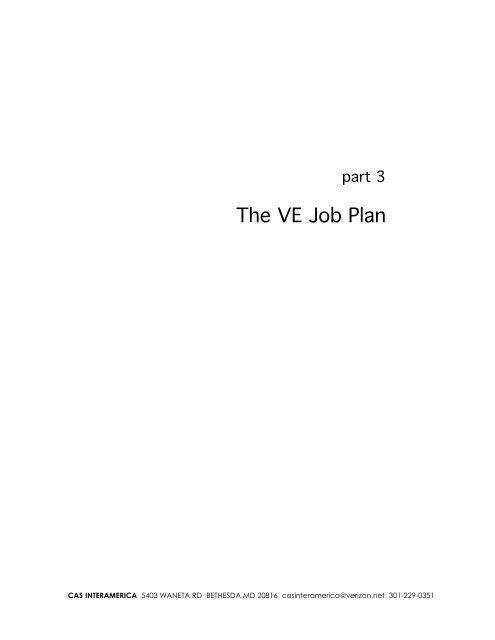

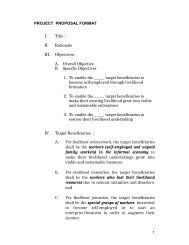
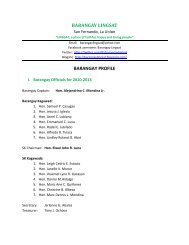
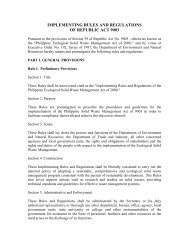
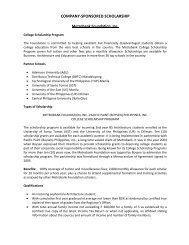
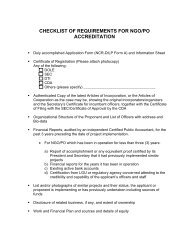
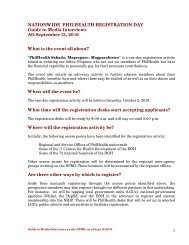

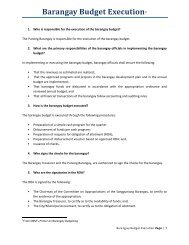
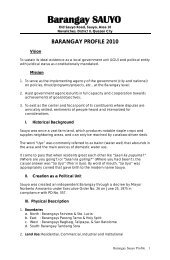
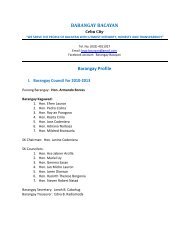
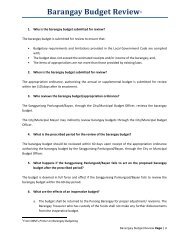
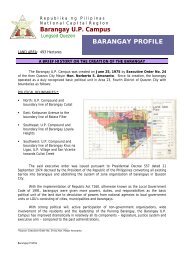
![[Cover Letter Format Guidelines]](https://img.yumpu.com/31846782/1/190x245/cover-letter-format-guidelines.jpg?quality=85)